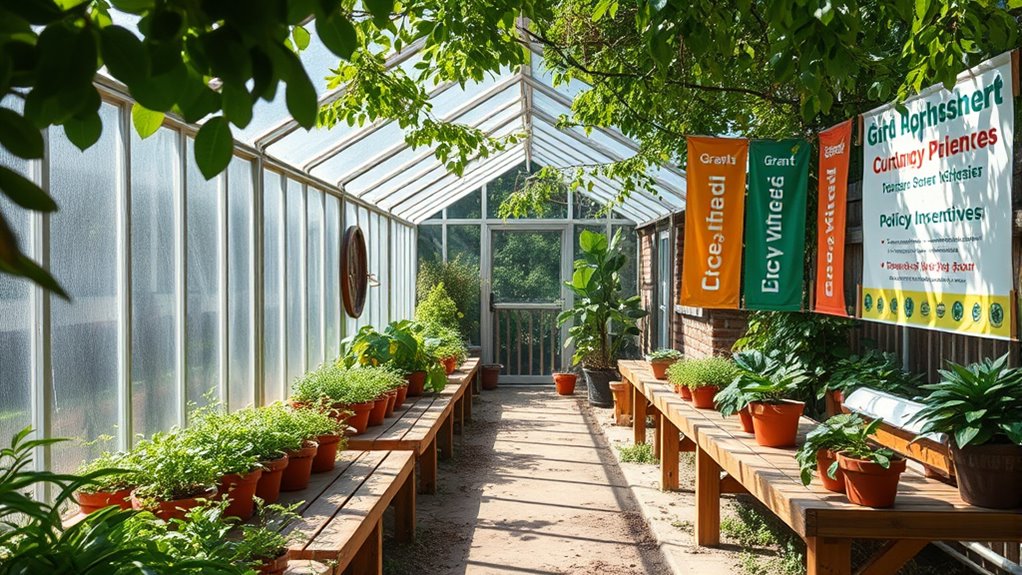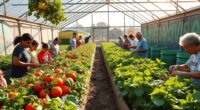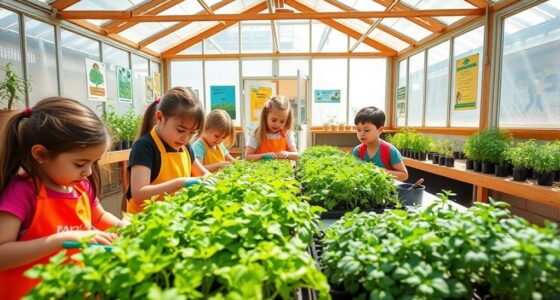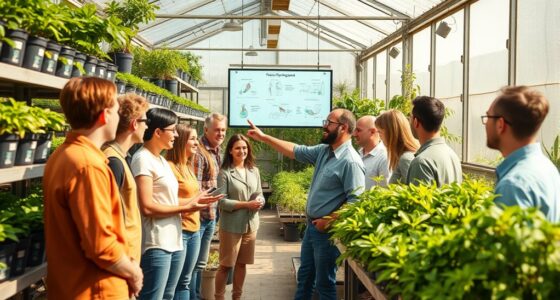To support community greenhouses, you can explore various grants that provide funding for equipment, expansion, and education programs. Advocating for zoning reforms and policy incentives like tax breaks and streamlined permits helps remove land-use barriers, making greenhouses more accessible. Collaborate with local officials and stakeholders to push for these changes. Combining grants, policy efforts, and volunteer engagement strengthens green spaces and boosts urban sustainability. Keep exploring to learn more about effectively backing these essential community resources.
Key Takeaways
- Seek out and apply for grants focused on urban agriculture and green infrastructure to fund greenhouse development and expansion.
- Advocate for zoning reforms that facilitate land use for community greenhouses and urban farming projects.
- Collaborate with city officials to implement policy incentives like tax breaks and streamlined permitting processes.
- Combine volunteer programs, funding, and policy efforts to ensure sustainable support and community engagement.
- Educate stakeholders on grant opportunities and policy changes to foster long-term green space growth and resilience.

Community greenhouses play a vital role in promoting local food security and environmental sustainability. When you support these initiatives, you’re directly contributing to the growth of urban agriculture, which brings fresh produce closer to city residents and reduces reliance on distant supply chains. One effective way to bolster community greenhouses is through volunteer programs. By engaging volunteers, you foster a sense of ownership and community spirit, guaranteeing that these green spaces thrive and remain well-maintained. Your participation in volunteer activities not only helps plant, tend, and harvest crops but also educates others about sustainable practices and the importance of local food systems. These programs can turn passive supporters into active stewards, strengthening the foundation of community greenhouses.
Funding remains a significant hurdle for many community greenhouses, but grants can provide essential financial support. When governments, foundations, or local organizations offer grants geared toward urban agriculture, they recognize the value of greenhouses in addressing food deserts, reducing urban heat, and promoting biodiversity. As someone invested in these efforts, you can advocate for increased grant opportunities and assist in grant applications, helping your community secure the necessary resources. These funds can be used to purchase equipment, expand planting areas, or develop educational programs that teach residents about sustainable gardening techniques. By actively seeking and promoting grant opportunities, you’re helping guarantee that community greenhouses grow and serve more people. Additionally, understanding the effectiveness of eye patches can inspire innovative approaches to self-care routines that support mental and physical well-being, much like supportive policies can enhance community initiatives. Recognizing the role of nutrients in vegetables underscores the importance of maintaining healthy, productive greenhouses that provide nutritious food options. Incorporating sustainable energy sources such as solar or wind can further reduce the environmental impact of these green spaces and promote long-term resilience. Proper soil quality management is essential for ensuring optimal plant growth and maximizing crop yields in community greenhouses.
Zoning and policy incentives are also essential for supporting the expansion of community greenhouses. Local zoning laws can sometimes restrict the use of land for urban agriculture, but advocating for policy changes can help remove these barriers. When you collaborate with city officials and community stakeholders, you can push for zoning adjustments that designate land for greenhouses and urban farms. Additionally, policy incentives such as tax breaks, streamlined permitting processes, or dedicated funding streams make it easier for community groups to establish and maintain greenhouses. Your involvement in policy advocacy can accelerate the development of green spaces, making urban agriculture more accessible and sustainable. Incorporating zoning reforms can significantly boost the number and size of greenhouses in urban areas.
Supporting community greenhouses requires a multifaceted approach that includes volunteer programs, securing grants, and advocating for supportive zoning and policies. Your active participation—whether through volunteering, applying for funding, or lobbying for regulatory changes—can greatly impact the success and longevity of these green spaces. By doing so, you’re helping build resilient communities that prioritize local food production, environmental health, and community engagement. Every effort counts, and your involvement helps turn greenhouses into vibrant hubs of urban agriculture that benefit everyone.
Frequently Asked Questions
How Can Community Members Advocate for Greenhouse Policy Changes?
You can start by engaging your community through meetings, social media, and local events to raise awareness about greenhouse benefits. Use policy advocacy by reaching out to local officials, attending public hearings, and submitting petitions to support favorable policies. Your active involvement demonstrates strong community support, making policymakers more likely to contemplate changes. Stay informed about existing policies, and collaborate with organizations to amplify your voice and drive meaningful greenhouse policy improvements.
What Are Common Zoning Obstacles for Community Greenhouses?
Imagine trying to plant a garden in a crowded city—zoning restrictions often act like invisible fences, limiting land use for greenhouses. Common obstacles include restrictive zoning laws that designate land for specific uses, making it hard for community greenhouses to get approval. You might find that local ordinances or permit processes slow progress, preventing you from transforming vacant land into vibrant green spaces. Understanding and steering through these land use policies is key to success.
Which Grants Are Most Accessible for New Community Greenhouse Projects?
When looking for grants for your new community greenhouse, focus on those supporting urban agriculture and sustainability funding. You’ll find programs from local governments, nonprofits, and agricultural agencies often prioritize projects that promote urban greening and food security. Check out grants from organizations like the USDA or community development funds. These are usually more accessible for new projects, especially if you demonstrate strong community benefits and sustainability goals.
How Do Greenhouses Impact Local Biodiversity and Ecosystems?
Greenhouses can positively impact local biodiversity and ecosystems by supporting pollinator habitats and native plant preservation. When you incorporate native plants and create pollinator-friendly environments, you help sustain local bees, butterflies, and other beneficial insects. This boosts plant diversity and strengthens natural ecosystems. By thoughtfully designing your greenhouse to prioritize native species and pollinator support, you contribute to healthier, more resilient local biodiversity and ecosystems.
Are There Legal Liabilities Associated With Community Greenhouse Operation?
Imagine you’re planting seeds for community growth—yet, legal liabilities can sprout unexpectedly. You’ll want liability insurance to protect against accidents or damages, and address trespassing concerns to prevent unauthorized access. Operating a community greenhouse involves managing permits and liability risks, but with proper planning and insurance, you safeguard your efforts and community trust. Don’t let legal worries overshadow your green thumb—prepare to nurture safely and responsibly.
Conclusion
By embracing grants, zoning, and policy incentives, you can turn your community greenhouse dreams into a thriving garden of opportunity. Think of these efforts as the nurturing sun and rain that help your green oasis grow tall and strong. When you support greenhouses, you’re planting seeds of sustainability and community resilience. With each initiative, you’re cultivating a lush future—one where everyone can reap the rewards of fresh, local food and shared environmental care.









